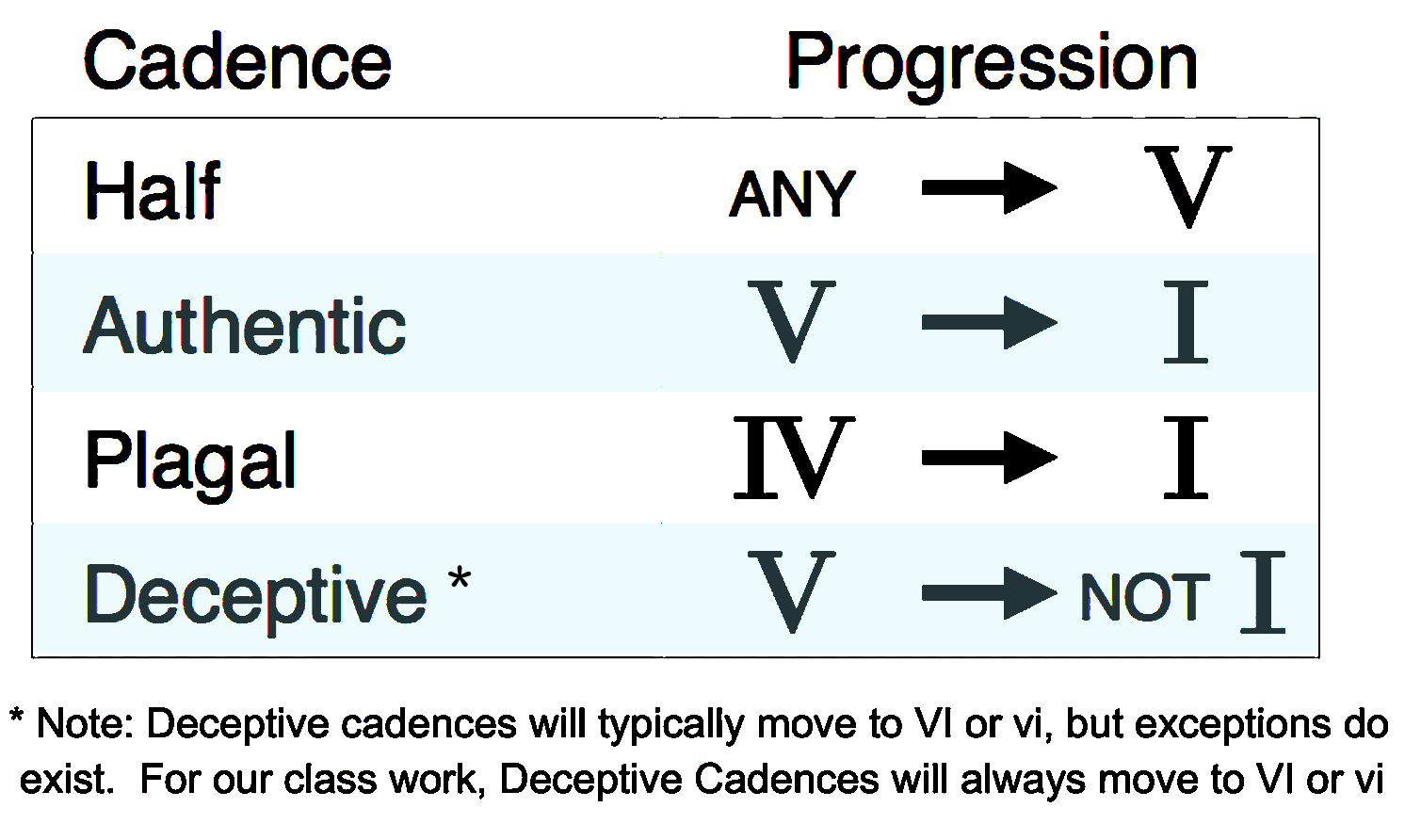13. Intro to Basic Cadences
In music, a phrase can be defined as a completion of a musical idea. A musical idea can be created through the deliberate organization of pitches (a melodic phrase), chords (a harmonic phrase), and note/rest values (a rhythmic phrase). Often, all three of these elements are combined within the same phrase.
An example of a melodic phrase, from Arlen and Harburg “Somewhere Over the Rainbow”
An example of a harmonic phrase, from Philip Glass “Piano Etude No. 1”
An example of a rhythmic phrase, from Maurice Ravel “Bolero”
To study harmony, it is necessary to disentangle it from its melodic and rhythmic elements. Viewing harmony in isolation, and studying how it is used in various types of music, reveals patterns of chord progressions that composers and songwriters often use to end a phrase. These chord progression patterns at ends of phrases are termed harmonic cadences.
Each of the four basic types of harmonic cadences utilizes the typical harmonic function of chords within a key to influence the expectation of the listener.
The three primary harmonic functions (Tonic, Predominant and Dominant) can explain the differences in sound of the basic harmonic cadences.
An authentic cadence is necessarily a dominant function chord that moves to a tonic function chord to conclude a phrase. Authentic cadences create the feeling of finality and satisfaction by strongly resolving the tension and expectation created by the preceding dominant function chord.
Authentic cadences can be further branched off into what is termed perfect and imperfect authentic cadences. The two cadences retain the dominant to tonic function at the ends of phrases, but differ in the make-up and movement of the chords and voices:
Inversions
Roman Numerals
Voice leading
Voice leading is a topic that requires its own chapter. For now, this chapter will consider all dominant to tonic function movements at ends of phrases as simply authentic cadences.
While an authentic cadence ends on two functions, dominant to tonic, a half cadence eliminates the actual resolution to the tonic and stops the phrase on a dominant function. The pause on the tension-filled dominant function effectively forces the listener to linger on the feeling of expectation. The tonic resolution often takes place at the start of the next phrase, thus releasing the tension of the listener.
Authentic and Half Cadences in J.S. BACH chorale “Aus meines Herzens Grunde”
The plagal cadence is the least frequently used of the four basic cadences. Rather than moving from dominant to tonic at the end of the phrase, the plagal cadence skips the dominant function and moves from the predominant function directly into the tonic. It is a more gentle return to the tonic that doesn’t include the tension created by a leading tone in the chord that precedes the tonic.
This cadence is colloquially referred to as the “Amen” cadence because it frequently makes its presence at ends of church hymns accompanied with the words A-men. (with the “A-” on the predominant chord, and the “-men” on the tonic chord).
The use of a plagal cadence in the “Hallelujah Chorus” from Handel’s Messiah
The deceptive cadence, true to its name, “deceives” the listener into feeling that the phrase is going to end on a strong tonic function. Instead, the chord progression moves from a dominant function chord into something that is either a weak tonic function triad (such as a [vi] chord) or an altogether different function chord. The deceptive cadence deceives the listener into expecting something that in fact does not occur. Technically and by definition, a deceptive cadence is a dominant function chord that moves into “anything” other than a tonic triad. In functional harmony music, however, the “anything” most frequently turns out to be the weaker tonic function vi chord (the triad built from the 6th scale degree.)
The use of the deceptive cadence in CHOPIN Prelude
Iconic British band The Beatles offers a wealth of material for music enthusiasts to examine every type of basic harmonic cadences in action.
An Authentic Cadence in THE BEATLES “Hey Jude”
A half cadence in THE BEATLES Yellow Submarine
A plagal cadence in THE BEATLES Let It Be
A deceptive cadencThe setup to a deceptive cadence in THE BEATLES "Ob-la-di Ob-la-da”"e in THE BEATLES “Ob-la-di Ob-la-da”
The way ends of phrases are treated harmonically can greatly affect how listeners perceive music. The various possibilities in harmonic cadences allows composers and songwriters to create a variety of sound.
Skilled composers can manipulate the emotions of the listener through their effective use of rhythmic, melodic and harmonic expectations in their music.
Understanding the use and effects of harmonic cadences is yet another tool that can help in the recognition and appreciation of music and how the music affects the listeners sensitivities.













![Deceptive cadences most often move from a dominant function to a [vi] chord](https://images.squarespace-cdn.com/content/v1/6261877a7b7ecb1104b7ada4/7945dde1-e22d-46a1-bccf-327a39b1898c/Deceptive+cadences+most+often+move+from+a+dominant+function+to+a+%5Bvi%5D+chord)







